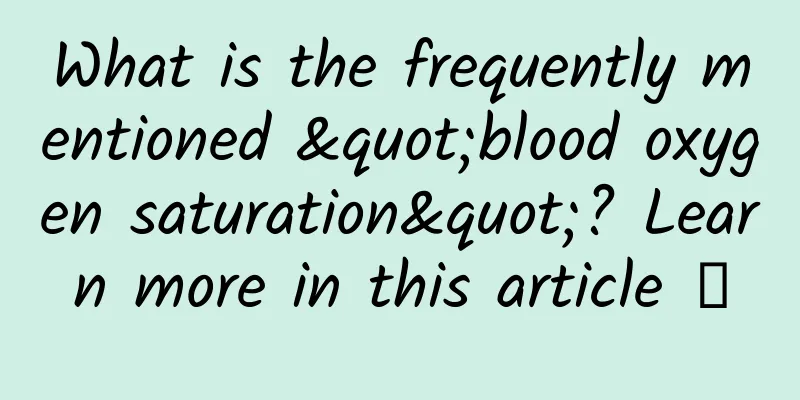What is the frequently mentioned "blood oxygen saturation"? Learn more in this article →

|
Blood oxygen saturation is a very important medical concept, and you must have heard of it often, but what does this word mean? You may not know. Next, let's talk about it in detail. 01 Oxygen transport form First of all, how is oxygen transported through the blood? You might think that gases can be dissolved in liquids, so when the blood passes through the lungs, it exchanges gases with the air, and some of the oxygen dissolves into the blood. This is correct, but the oxygen dissolved in the blood only accounts for a very small part of the blood's oxygen content, about 1.5% of the total. So, how is the rest of the oxygen transported in the blood? This requires another way, called chemical binding . There is a component in the blood called hemoglobin. When the blood exchanges gases in the lungs, the oxygen in the air will combine with hemoglobin to form oxygenated hemoglobin . To use an analogy, the circulatory system is a railway, and hemoglobin is a train running on the railway. Its function is to transport oxygen to various parts of the body. When it is loaded with goods, it is equivalent to oxygenated hemoglobin. The blood that carries more goods is arterial blood, and because oxygenated hemoglobin is bright red, our arterial blood is particularly bright. The blood that carries less goods is venous blood, and because hemoglobin is purple-blue, venous blood looks darker. But the question is, how much "cargo" does arterial blood and venous blood carry? If we simply distinguish them by color, it is too rough. We need a more scientific and accurate indicator to describe the oxygen content in the blood. In fact, doctors use many indicators to complete this task, and the most widely used and popular indicator is blood oxygen saturation. 02 What is blood oxygen saturation? Blood oxygen saturation is the ratio of oxygen content to oxygen capacity . So to understand what blood oxygen saturation is, we need to know these two concepts. The so-called oxygen capacity refers to the maximum amount of oxygen that hemoglobin can bind to in 100 ml of blood. Using the analogy we just gave, it is the maximum capacity of 100 ml of blood to transport goods. The so-called oxygen content refers to the actual amount of oxygen that hemoglobin in 100 ml of blood can bind to, which is the actual load of goods transported by the train. Let's take another analogy. Suppose a water cup can hold up to 1000 ml of water, which is its capacity. But we actually only put 950 ml of water in this water cup, which is its content at this time. We divide the content of 950 ml by the capacity of 1000 ml to calculate the degree of water in this water cup. In the same way, blood oxygen saturation also reflects the degree of oxygen content in the blood in this way. So, what value should the blood oxygen saturation be maintained at under normal circumstances? When a healthy person is quiet and inactive, the blood oxygen saturation of arterial blood is higher than 95%, about 98%, and the level of venous blood is about 75%. At this point, you can probably understand that hemoglobin is a train that transports oxygen, but when it arrives at the destination, not all carriages unload their cargo, but only a small part of the carriages unload their cargo. The point is that the difference between the oxygen saturation of arterial blood and venous blood is only 98% to 75%, which is not that big. In other words, when the train carrying oxygen is unloaded, it only unloads more than 20% of the entire trainload. When the oxygen saturation of arterial blood decreases, although it seems that the value decreases not much, it is already a large part of the more than 20%, so it has a great impact on the human body. Generally speaking, when the arterial blood oxygen saturation of an adult is greater than 95%, it means that the blood oxygen level is within the normal range . Once it is lower than 95%, we should be alert. If it is lower than 90%, we definitely need to go to the hospital for treatment. The next question is, under what circumstances will the oxygen saturation of arterial blood decrease? There are many reasons for this, one of the more important ones is lung function . Whether the pulmonary ventilation function or the gas exchange function is impaired , the blood oxygen saturation will decrease . The reason is very simple. As I said just now, oxygen is combined with hemoglobin in the lungs. If there is a problem with the lung function, hemoglobin, as a freight train, cannot load oxygen in time, and the oxygen content in the blood will naturally decrease. This is reflected in the test value, that is, the blood oxygen saturation decreases. Simply put, the value of blood oxygen saturation can also let us indirectly understand the condition of the lungs. 03 How to measure blood oxygen saturation? Since blood oxygen saturation is so important, how should we measure it? There are two commonly used methods. The first is blood gas analysis , which is often used in hospitals. The second method can be used in hospitals and at home, which is to measure fingertip oxygen saturation . Let's talk about blood gas analysis first. Since it is to measure the blood oxygen saturation in arterial blood , the most direct method is of course to draw arterial blood for measurement . This is of course very accurate, but it is an invasive examination . Whether we usually check blood routine or liver and kidney function, we draw blood from the vein. The blood pressure in the vein is relatively low, and the flow rate is relatively slow, so the blood drawing operation is safer. Arterial blood is different. The arterial pressure is relatively high and the flow rate is relatively fast, so the operation is of course more difficult. Therefore, the advantage of blood gas analysis is that direct blood drawing is highly accurate, but it can usually only be performed in hospitals. The risk of operating it at home is very high. Fortunately, we have a second method, which is to measure the oxygen saturation of the fingertips . The principle of this technology is that the ability of hemoglobin to absorb light changes under different oxygen content. So scientists use this property to use light-emitting diodes to emit red light with a wavelength of 660 nanometers and infrared light with a wavelength of 940 nanometers, and then measure the absorption of hemoglobin and oxyhemoglobin to these two measuring lights, and then calculate the blood oxygen saturation of arterial blood. This method is called dual-light spectroscopy . After all, this technology uses light to irradiate the body without needle pricks, so this technology is non-invasive . In layman's terms, it is to use a very sophisticated device to put on the finger, and we can see the value of arterial blood oxygen saturation on the screen. Because it is measured on the finger, this value is often called finger pulse oxygen by doctors. Comparing the principles of blood gas analysis and finger pulse oximetry, it is easy to find that blood gas analysis is more accurate. However, in most cases, the accuracy of finger pulse oximetry is also very high. At the same time, it is simple to operate and non-invasive, which is why it is widely used. So, under what circumstances may the value of finger pulse oximetry be inaccurate? The first is the situation of severe hypoxia. This is inevitable because when the machine was originally designed, it was impossible to let patients with severe hypoxia serve as volunteers to calibrate the instrument's values. Those who can serve as volunteers are healthy people, so the finger pulse oximeter has this inherent deficiency. In a state of severe hypoxia, its value is inaccurate. Of course, it can at least indicate that the patient is in a state of hypoxia in the early stages. If we suddenly experience shortness of breath, chest tightness, difficulty breathing and other discomforts, we can self-test the finger pulse oxygen saturation. Once it is lower than the normal value, we should go to the hospital immediately for further diagnosis and treatment. The second situation is easier to understand. If the machine is not connected properly and there is poor contact with the finger, or if you have painted black, green, or blue nail polish, or if your skin color is too dark, it may also cause inaccurate readings. It is enough for us to understand the above two situations. As for other possibilities, we should leave it to professionals, that is, doctors to deal with. Author: Sun Yifei Review | Ding Heyuan, deputy chief physician, Shanghai Fifth People's Hospital, Fudan University |
<<: Are you still carpooling or group-fighting? Let's ride on a rocket together.
>>: Pioneer 10: A tour of the planets
Recommend
Why Google Cardboard is the future of virtual reality
"Experiencing virtual reality with cardboard...
How to create a high-click title and double the number of readers in 10 minutes?
In today's world of information explosion and...
Short video advertising optimization tips for Tik Tok, Kuaishou, etc.!
SEMers and information flow advertising optimizer...
Apple executives: We will not consider supporting multiple users for Face ID in the short term
Apple's current Face ID only supports a singl...
Notice on Retirement for Those Over 60 in 2022: Which places have issued retirement orders? Attached the latest news
Since the beginning of 2021, my country's con...
The power of fermentation: the contribution of production technology to the nutritional value of cheese
Cheese is one of people's favorite dairy prod...
What is the difference between a 5-cent egg and a 5-dollar egg? The answer is...
Everyone knows that eggs are rich in nutritional ...
It's called the "Queen of Flowers", but it has no petals...
In addition to the common wintersweets, plum blos...
Google researchers discover Apple introduced improved iMessage security for iOS 14
Apple released iOS 14 last fall, introducing a ne...
China Charging Alliance: Operation status of national electric vehicle charging and swapping infrastructure in February 2022
National Electric Vehicle Charging and Replacemen...
Introducing 5 data-driven and practical customer acquisition methods
Admittedly, in many cases, the acquisition of new...
Cold air is coming! Don’t wear your winter clothes directly from the bottom of the box, as it may cause...
Recently, cold air has hit Temperatures hit recor...
Started a company with 0 yuan and made more than 300,000 yuan in a few days without spending a penny
How to start a company and make money with 0 yuan...
User retention strategy for product operation!
From the user's perspective, each product act...
The Forbidden City: Let’s talk about those little-known little-known facts about the palace~
The Forbidden City is a beautiful red It brings t...









